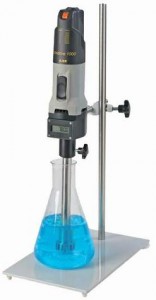Small Sample Emulsifying with a Lab Homogenizer
 How to Emulsify Small Samples With a Lab Homogenizer
How to Emulsify Small Samples With a Lab Homogenizer
The old saying “oil and water don’t mix” does not hold true all the time. While it is true that oil and vinegar in the salad dressing cruet will separate on standing, homogenized milk holds the cream in suspension on the supermarket shelf and in your refrigerator. Likewise, many cosmetics are emulsions of immiscible constituents. Mixing of mutually insoluble phases to achieve a suspension is accomplished in R&D departments by employing a lab homogenizer to emulsify small samples.
Advantages of Laboratory Homogenizers in R&D
Lab homogenizers such as those offered by CAT Scientific are designed for use with small samples. The definition of “small” is open, because, depending on the model selected, these versatile tools can work with test-tube sized samples as small as 0.1 ml up to 20 liter beakers. The point is, using a lab homogenizer allows researchers to conduct experiments with small samples that may be expensive. But the results of the experimentation are aimed at developing a process that can be scaled up to commercial production when optimum processing parameters are defined.
Another advantage offered by lab homogenizers is their ability to process samples of different physical characteristics. At CAT Scientific we identify sample properties as Viscous, Low Viscosity, Fine and Knife, designated V, N, F and K as defined in our dispersing tools application table. Another benefit is that these dispersing tools are interchangeable. This means researchers can perform a variety of tasks with the same drive motor, simply by switching out one generator assembly for another.
This interchangeability adds greatly to the versatility of lab homogenizers, enabling them to perform a variety of tasks such as cell disruption, emulsifying, dispersion, dissolving and mixing.
Lab Homogenizer Components
Lab sample processing is accomplished by the homogenizer generator that is powered by the variable-speed drive motor. Homogenizer generators consist of two compatibly machined components: the rotor attached by a shaft to the drive motor and the stationary stator screwed tightly to the homogenizer drive shaft tube. The drive shaft tube is, in turn, firmly affixed to the drive motor housing. These components are defined as CAT rotor-stator generator assemblies.
How Lab Homogenizers Work
It is strongly recommended that lab homogenizers be firmly mounted on the supplied stand and clamp to avoid possible breaking of test tubes and beakers. This caution applies as well to our hand-held homogenizer drive which is also shipped with a support stand.
The generator assembly should be completely immersed in the sample. When samples are in beakers the generator should be at a slight angle and away from the center. This avoids creating a vortex and helps assure that the entire sample is processed through the generator.
Start the drive motor slowly and then ramp up the speed to the desired level. This helps avoid splashing.
The revolving sharp-bladed rotor draws sample up into the generator and violently impels it against the machined knife edges of the compatible stator thus performing the homogenizing action. The process continues until the desired results are achieved.
How to Change Homogenizer Generator Assemblies
As noted, different generator assembly configurations are employed to achieve desired results. This is one of the major advantages of using these tools in the R&D lab. Our video on how to change homogenizer generators explains the steps to take.
We offer these additional tips on emulsifying small samples with a lab homogenizer.
- Be certain that the rotor and stator are tightly mounted to the rotor drive shaft and stator tube. Use the supplied tools to ensure proper assembly/disassembly as described in our video. A loosely mounted rotor-stator assembly could introduce air into the sample.
- Cleaning and disinfecting generator assemblies are important steps to avoid cross-contamination of samples and the potential of infecting researchers if cut by sharp edges on rotors and stators. These procedures may be guided by government agency and/or trade association recommendations. We offer suggestions in our post on sterilizing lab homogenizers.
- Add to the utility and value of a lab homogenizer drive motor by coupling it to flow-through chambers for continuous or in-line processing. Analytical mills are useful attachments that reduce samples to manageable size. Information on these tools is accessed via our page on homogenizer drives.
Rely on the liquid processing professionals at CAT Scientific for help in solving your homogenizing challenges and suggestions on the proper CAT homogenizer configurations. You can help this process by filling out our homogenizer questionnaire.
